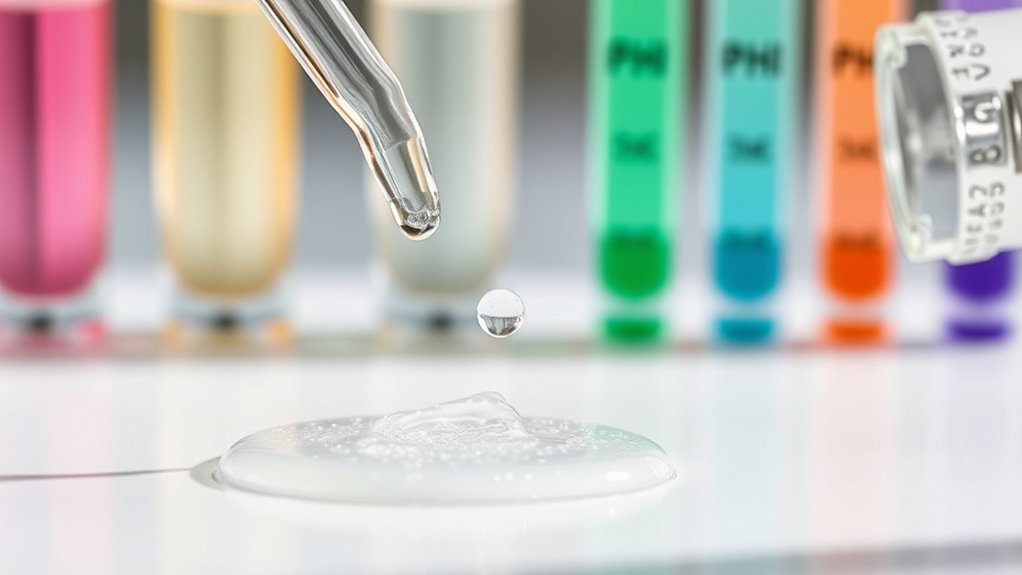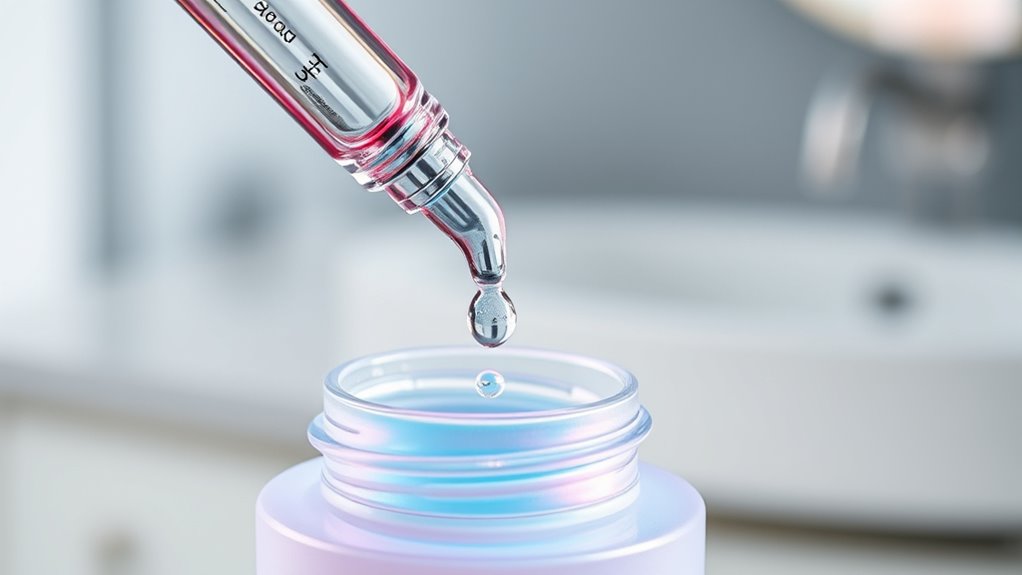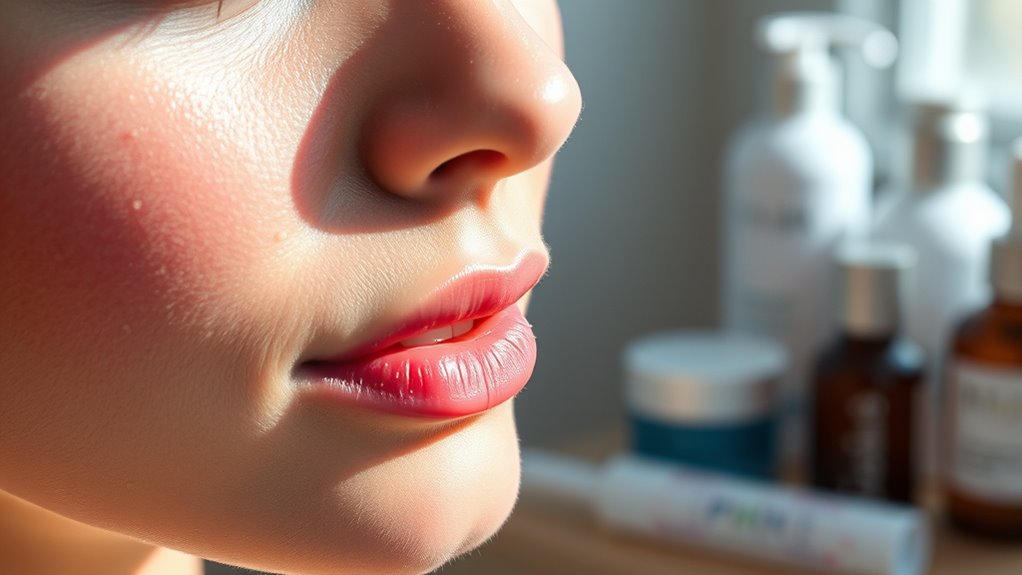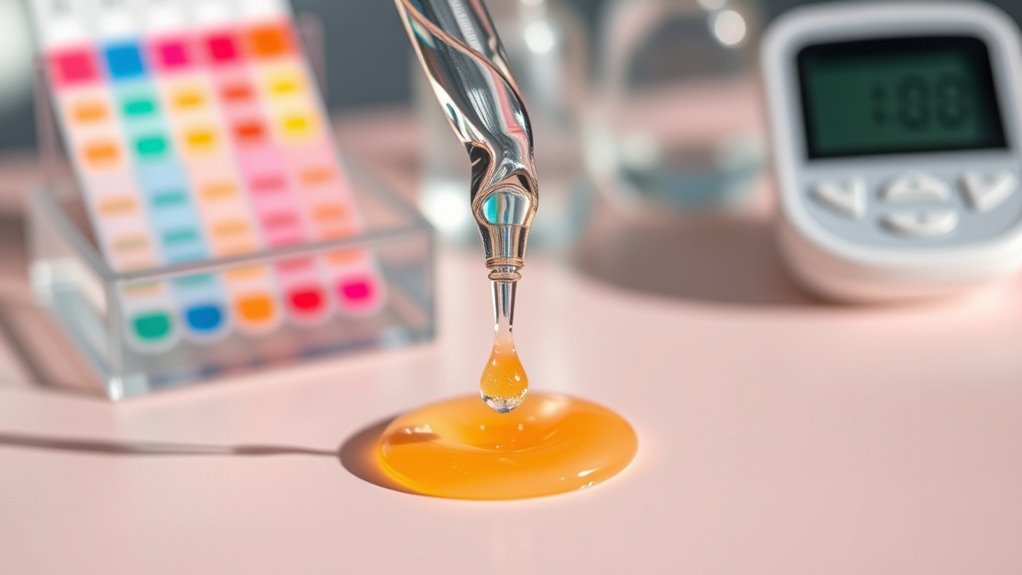Your skin’s pH level is a hidden key to how well your skincare works. The natural acidity, around 4.5 to 5.5, supports your skin’s barrier, microbiome, and product absorption. When your pH is off, it can cause dryness, irritation, and breakouts, making products less effective. Staying in the right pH range helps maintain healthy skin and maximizes product benefits. Keep going to discover how to keep your skin pH perfectly balanced.
Key Takeaways
- pH levels influence product stability and ingredient efficacy, ensuring active ingredients work effectively without degradation.
- A skin’s natural pH maintains the acid mantle, protecting against bacteria and environmental damage, enhancing overall skin health.
- Proper pH matching between products and skin optimizes absorption and minimizes irritation or disruption of the skin barrier.
- Imbalanced pH can cause dryness, irritation, breakouts, and redness, reducing skincare effectiveness and compromising skin resilience.
- Choosing pH-balanced products supports microbiome health and promotes long-term skin clarity, texture, and barrier function.
What Is Ph and Why Does It Matter in Skincare?

Understanding pH is vital because it measures how acidic or alkaline your skin is. Your skin’s natural pH level typically ranges from 4.5 to 5.5, making it slightly acidic. This acidity helps maintain the skin’s barrier, keeping out bacteria and pollutants while locking in moisture. When your skin’s pH balance is disrupted, it can lead to issues like dryness, irritation, or breakouts. Using skincare products with a pH that’s too high or too low can disturb this balance, weakening your skin’s defenses. That’s why choosing products that match your skin’s natural pH is essential. Maintaining the right pH supports overall skin health, ensuring your skin remains resilient, smooth, and properly hydrated.
The Science Behind Ph Balance and Skin Health

The science behind pH balance and skin health reveals that your skin’s slightly acidic environment is essential for its protective functions. This acidity, typically around a pH of 4.5 to 5.5, helps maintain the skin’s barrier, preventing harmful bacteria and pollutants from entering. When your skin’s pH shifts, it can become more vulnerable to irritation, dryness, and infections. An ideal pH level supports the production of ceramides and natural oils, keeping your skin moisturized and resilient. Additionally, maintaining this balance encourages healthy cell turnover and reduces inflammation. Your skin’s microbiome, the community of beneficial microbes, thrives in this slightly acidic environment, further boosting your skin’s defenses. Proper air quality can influence your skin’s pH balance and overall health, as pollutants and irritants can disrupt its natural acidity. Factors such as diet and hydration also play a crucial role in maintaining a healthy skin pH, reinforcing the importance of comprehensive skin care. Maintaining a consistent skincare routine can help preserve this delicate balance and protect your skin from external stressors. Overall, a balanced pH is vital for maintaining healthy, resilient skin, especially considering how Skincare Products can influence this delicate balance.
How Ph Levels Affect Product Effectiveness

Your skincare products work best when their pH levels match your skin’s natural balance, ensuring compatibility. If the pH is off, it can reduce the product’s effectiveness or cause irritation. Understanding pH helps you choose products that deliver ideal results and stay stable over time. Proper product formulation takes pH into account to maximize efficacy and skin safety. Additionally, maintaining an optimal pH can support skin health and promote a more resilient skin barrier. Regular testing and adjusting of formulations can help maintain the correct reservoir system for consistent pH levels, ensuring that the product remains effective throughout its shelf life. Tuning and vehicle compatibility also play a role in how well a product performs on your skin. Using formulations with appropriate filtering technology can further enhance product stability and effectiveness.
Ph Balance and Skin Compatibility
Since pH levels directly influence how well skincare products work, maintaining the right pH balance is essential for skin compatibility. When your skin’s pH is balanced, it helps your skin barrier stay strong, preventing irritation and sensitivity. Products with a pH that’s too acidic or alkaline can disrupt this balance, leading to dryness, redness, or breakouts. For example, using a cleanser that’s too alkaline can strip away natural oils, leaving your skin vulnerable. Conversely, products that match your skin’s natural pH—around 4.5 to 5.5—are more likely to absorb effectively and support healthy skin. Paying attention to pH helps guarantee your skincare routine enhances your skin’s health without causing adverse reactions. Additionally, choosing skin-friendly home furnishings can help create a calming environment that supports overall skin wellness. Understanding the importance of consistent messaging in skincare can also help you make informed choices that promote long-term skin health. Recent innovations in AI detection methods emphasize the importance of precision and accuracy, which parallels the need for precise pH levels in skincare to achieve optimal results. Regularly monitoring skin pH levels can further optimize your skincare effectiveness and prevent issues before they arise. Maintaining proper pH is also crucial for the effectiveness of active ingredients in various skincare formulations. Ultimately, a balanced pH promotes skin harmony and improves overall compatibility.
Product Stability and Efficacy
Maintaining the right pH level in skincare products is essential for ensuring their stability and effectiveness over time. When pH drifts outside the ideal range, ingredients can degrade or become less active, reducing their benefits. For example, acids like AHAs work best at specific pH levels, and if the product’s pH is off, they may lose potency. Stability also depends on how well ingredients resist oxidation or microbial growth, which pH influences. Proper pH balance can also help preserve the vitality of natural ingredients and extend the shelf life of products. Ensuring the correct pH is vital for preventing product spoilage and maintaining ingredient integrity. Additionally, formulation stability is influenced by pH, which is crucial for developing advanced formulations that adapt to changing conditions. Incorporating pH-responsive ingredients can further enhance product stability and efficacy, especially in dynamic environments. Understanding AI safety measures can be crucial for developing advanced formulations that adapt to changing conditions.
Signs Your Skin’S Ph Is Out of Balance

When the skin’s pH level is out of balance, it often shows through noticeable signs. You may notice your skin feels unusually dry, tight, or flaky, which indicates a disrupted barrier. Blemishes and breakouts can also appear more frequently, as an imbalanced pH hampers your skin’s natural defenses. Additionally, increased sensitivity or redness might occur, making your skin more reactive to products or environmental factors. Here are some key signs to watch for: 1. Persistent dryness or flakiness 2. Frequent breakouts or irritation 3. Redness or heightened sensitivity. If you experience these symptoms regularly, your skin’s pH might need adjustment to restore its natural balance and health. Proper hydration and choosing pH-balanced skincare products can help maintain optimal skin conditions. Furthermore, using skincare products that are vetted and formulated to support your skin’s pH balance can make a significant difference in maintaining healthy, resilient skin. Understanding your skin’s acid mantle and its importance in protecting against bacteria is essential for overall skin health, and maintaining the skin’s natural barrier can also be supported by hydrating ingredients. This knowledge can guide you in selecting the right products.
Choosing Products With the Right Ph for Your Skin Type

Choosing skincare products that match your skin’s pH needs can make a significant difference in maintaining its health and balance. If you have oily or acne-prone skin, look for products with a slightly acidic pH around 4.5 to 5.5, which helps control oil and bacteria. For dry or sensitive skin, choose products closer to neutral pH, around 5.5 to 6.5, to avoid irritation. If your skin is normal, you have more flexibility but still benefit from balanced pH levels. Always check labels for pH information or look for products labeled as pH-balanced. Using the right pH products guarantees your skin’s protective barrier stays intact, reducing irritation and promoting a healthier, more resilient complexion.
Adjusting Your Routine for Optimal Ph Levels

To guarantee your skincare routine supports your skin’s ideal pH levels, it’s important to incorporate steps that help balance and maintain acidity after cleansing and treatment. First, use a gentle toner with a slightly acidic pH to restore your skin’s natural balance. Second, consider applying serums containing ingredients like niacinamide or witch hazel, which help stabilize pH levels. Third, finish with a moisturizer suited to your skin type, which forms a barrier to prevent pH fluctuations caused by environmental factors. Regularly monitoring your skin’s response and adjusting products accordingly ensures peak pH balance. Incorporating skin pH management strategies can further optimize your skincare results. Additionally, being aware of regulatory frameworks around data privacy can inform your choices when selecting skincare products with digital tracking features. Staying informed about product authenticity markers can help you avoid counterfeit products and ensure you’re using effective formulations. By following these steps, you support your skin’s natural defenses, improve absorption of active ingredients, and enhance overall skincare effectiveness.
Myths and Facts About Ph and Skincare

Many common beliefs about pH levels in skincare aren’t entirely accurate, leading you to make unnecessary or even harmful choices. Some think that anything acidic is bad, while others believe alkaline products are always beneficial. The truth is, your skin’s pH is delicate and varies slightly throughout the day. Using products with the wrong pH can disrupt your skin’s barrier. Here’s a quick myth-busting table:
| Myth | Fact |
|---|---|
| All acidic products damage skin | Some acids, like AHAs, improve skin when used correctly |
| Alkaline cleansers are better | They can strip natural oils and disrupt pH balance |
| pH levels don’t matter in skincare | Proper pH supports healthy skin barrier |
Knowing the facts helps you choose products that truly work for your skin.
Frequently Asked Questions
Can Diet Influence My Skin’s Ph Balance?
Your diet definitely influences your skin’s pH balance. Eating too many acidic foods like processed snacks and sugary drinks can lower your skin’s pH, making it more acidic. On the other hand, incorporating alkaline-rich foods like fruits and vegetables helps maintain a balanced pH. When your diet supports a healthy pH, your skin can better defend against bacteria, reduce irritation, and stay looking fresh and vibrant.
How Does Water Quality Impact Skin Ph?
Think of water quality like a mirror reflecting your skin’s health. Poor-quality water, with high mineral content or harsh chemicals, can throw off your skin’s natural pH balance, making it more alkaline or acidic than it should be. This imbalance can lead to irritation, dryness, or breakouts. To protect your skin, use gentle, filtered water for cleansing, ensuring your skin’s pH stays in a healthy, balanced range.
Are Natural Skincare Ingredients Better for Ph Balance?
You might wonder if natural skincare ingredients are better for pH balance. Generally, they tend to be gentler and closer to your skin’s natural pH, helping maintain balance and reduce irritation. However, not all natural ingredients are automatically ideal; some can disrupt pH levels. It’s best to choose products formulated to support your skin’s natural acidity, regardless of whether they’re natural or synthetic, for maximum skincare effectiveness.
Does Age Affect Skin’s Ph and Its Response to Products?
You might wonder if age influences your skin’s pH and how it reacts to products. As you age, your skin’s pH can shift, becoming more alkaline, which may affect its barrier function and responsiveness. This means older skin might need different formulations or pH-balanced products to stay healthy and effectively absorb ingredients. Paying attention to your skin’s changing needs helps make certain your skincare routine remains effective over time.
How Quickly Can I See Changes After Adjusting Ph Levels?
When you adjust your skin’s pH levels, you might start noticing changes within a few days to a week. Your skin can respond quickly, especially if you’re consistent with pH-balancing products. However, visible improvements like smoother texture or reduced irritation may take a couple of weeks. Keep monitoring your skin’s response and stay patient; balancing pH is a gradual process that enhances overall skin health over time.
Conclusion
Understanding the subtle dance of pH levels can unlock your skincare’s full potential. When you tune into your skin’s delicate balance, you’re gently guiding it toward harmony and radiance. Remember, sometimes the tiniest adjustments—like choosing the right product—can make a world of difference. Trust your skin’s quiet wisdom, and with mindful care, you’ll reveal a healthier, more luminous you that’s beautifully in tune with itself.









